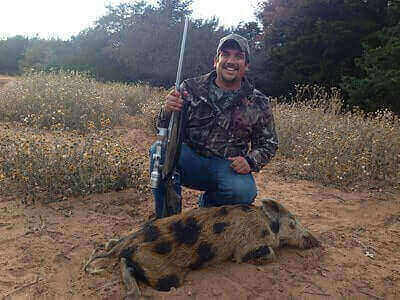Disclosure: We may earn commissions if you purchase products after clicking on a link from our site.
Do you want to hunt hogs? Do you want to learn how to hunt hogs? Hog hunting has become popular in the last few decades in the southern states. Hunting hogs is dangerous as they have very sharp teeth and hooves, and are very large and aggressive when cornered.
In this article, we discuss how to hunt hogs during the day, how to hunt hogs at night, how to hunt hogs on public land, how to track hogs, and also give hog hunting tips for beginners.
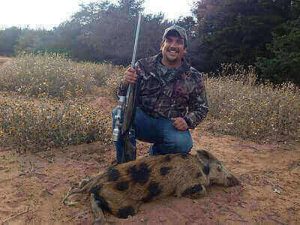
Table of Contents
How To Hunt Hogs
1. Scout the Hogs
When you want to hunt for hogs during the day, it is always good to do some scouting. Hogs are not easily seen during the day as they are found in thick cover. Scouting them can help you with the information you need to pattern their movements.
You will gather valuable information such as when they come out to eat, drink, wallow, etc. Keep your eyes open for hog tracks, droppings, rooting, rubs, wallows, and hair strands caught in barbed-wire fences.
2. Trail Cameras
If you have a good idea of the areas you think hogs frequent, you can set up trail cameras to collect information about their movements, behaviors, when they come out, and when they go back to cover. You can also learn their travel routes from bedding areas to food and water sources. We reviewed the best trail cameras on the market today and you can read them from this link.
3. Water Sources
Locating water sources is crucial when hunting hogs, as these animals require regular access to water for hydration and cooling off, especially in hot climates. Hogs typically frequent areas near creeks, rivers, ponds, or natural springs, making these spots prime locations for hunting.
Additionally, wallows—muddy depressions created by hogs for cooling—are often found near water sources and serve as important indicators of hog activity. Hunters should scout these areas carefully, looking for signs such as tracks, droppings, and rooting activity, which can signal recent hog presence. Setting up near water sources during early morning or late evening hours when hogs are most active increases the chances of encountering these elusive animals and securing a successful hunt.
4. Food Sources
Locating food sources is essential for successful hog hunting, as hogs are opportunistic omnivores that feed on a variety of vegetation, roots, fruits, and small animals. Hunters should scout for areas abundant in food, such as agricultural fields, pastures, oak groves, and areas with dense undergrowth where hogs can forage for roots and insects.
Signs of hog activity, such as rooting, trampled vegetation, and overturned soil, can indicate their presence and help hunters pinpoint potential feeding areas. Setting up near these food sources, particularly during early morning or late evening when hogs are most active, increases the likelihood of encountering them during a hunt.
Additionally, using bait such as corn or other hog attractants near these food sources can further attract hogs and improve hunting success.
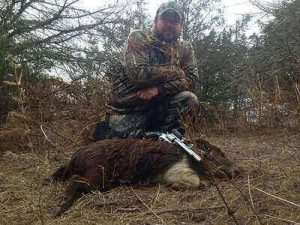
5. Predator Calls
You can use predator calls to get them from their cover and out in the open. Make calls in short bursts from a downwind position. Hogs usually respond quickly to predator calls and come out of their cover. Usually, they will be charging when responding to a predator call, therefore, you want to be at a safe distance.
It gets even better: use recorded sounds of piglets in distress and you will definitely get the attention of sows. They are extremely protective and will come into the open, out of cover, if they think their little ones are in danger. If you want to know the best predator calls available on the market today, then click this link.
6. Dusk & Dawn
When hunting wild hogs, timing is very important. You will have to know when to go out and hunt hogs. Hogs are most active at dawn and dusk. Therefore, you have to be out in the fields early in the morning or late in the evening to hunt hogs.
7. Bait Pile/Feeder
After gathering information from scouting and the trail cameras, you can set up a bait pile or feeder to lure them out of their cover. Use bait that is high in protein and fat like corn, sweet potatoes, nuts, overripe fruits, shelled corn, and acorns. Using a bait pile is very popular for hunting hogs at night but can also be used to hunt hogs during the day.
8. Decoys
Using decoys when hunting hogs can be an effective strategy to attract these elusive animals into shooting range. Decoys mimic the appearance and behavior of real hogs, drawing curious or territorial pigs towards them.
Hunters often place decoys strategically in areas frequented by hogs, such as feeding or bedding areas, to increase the likelihood of success. Decoys can be made from various materials, including foam, plastic, or even taxidermy mounts, and come in different shapes and sizes to replicate different hog sizes and postures.
Additionally, some decoys are designed with motion or sound features to add realism and further entice approaching hogs. Overall, using decoys can enhance the hunting experience by increasing visibility and attracting hogs within range for a successful harvest.
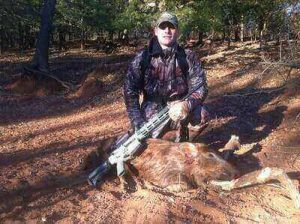
9. Set Up A Stand
You can set up a tree stand or ground blind close to their travel routes to intercept them when they head to food or water sources early in the morning or late in the evening. You must get to your site very early undetected to be successful. Take all steps to control your human scent. You can read our review of the best climbing treestands or the best hunting ground blinds on the market today from these links.
10. Implement A Drive
Wild hogs are notorious for remaining in thick cover during the day. if you have implemented many strategies to lure hogs out of their cover and into the open without any success, you can implement a drive if you have good reason to believe they are in an area.
Here’s how it works: let one hunter take a position with a good line of sight while another hunter slowly walks, with the wind at their back through the cover. When the hogs pick up the movement and human scent, it will get them to move from their cover and toward the shooter. The shooter must be aware of the direction that the driver will come from and the driver knows where the shooter is positioned.
11. Hunt Hogs With Dogs
You can use tracking dogs to help you hunt feral hogs. There are trained dogs that will pursue and “bay up” hogs for the hunter to get a good shot. Curs and Catahoula are dog breeds that do this job very well. Similarly, there are catch dogs like Dogo Argentines and pit bulls that will rush in, grab, and hold a wild hog until the hunter arrives and takes it down.
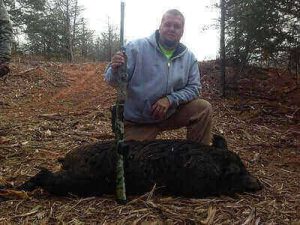
How To Hunt Hogs At Night
You can also hunt hogs at night as many of them have learned to be more active at night than during the day because of the hunting pressure. Hunting hogs at night can be more challenging because of visibility. However, there are thermal scopes and night vision binoculars that can make it easier.
1. Setup Bait Pile
Many night hunters set up a bait pile to lure the wild hogs to the bait. Before you use bait, make sure it is legal in your state. They then take up a position with a good firing range from the bait pile.
2. Wind Direction
When hunting hogs at night, you want to be very careful of the wind direction. Hogs don’t have the best eyesight but have a very good sense of smell which is part of their defense mechanism. You don’t want the wind to take your human scent to the hogs. Always hunt with the wind in your face. Take along some powder put it in the air and observe the direction it goes in. Or just throw up some dirt instead.
3. Thermal & Night Vision Scopes
To resolve the issue of visibility when hunting feral hogs at night, you can use thermal scopes and night vision binoculars, spotting scopes, or monoculars. The thermal scope will indicate if there is a hog from the heat display and the vision scopes can confirm the information. You can have a hunting buddy so that using both scopes can be used efficiently when hunting hogs at night.
Wild hogs are less wary during the night than in the daytime. This allows you to get closer to them. You can set up feeders with lights that come on when the hogs get closer to the feeder thus alerting you of their presence. You can also find feral hogs on the edges of crops during the night. You can read about the best night vision binoculars or best night vision monoculars from these links.
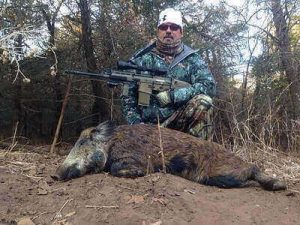
How To Hunt Hogs On Public Land
1. Hunting feral hogs on public land is very similar to hunting them on private land or in the open country. However, there will be more hunting pressure in certain areas and at some time.
2. Many hunters will go on the weekends and will all hunt in the same areas. When hunting public land, try to go when many hunters are not hunting like during midweek.
3. Additionally, scout the public ground before you hunt to get familiar with the landscape and find areas far away from the main hunting areas most hunters stake out.
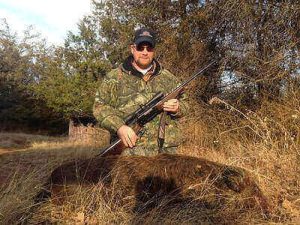
4. Talk to the wildlife biologist for the area to learn about the movements and behaviors of the feral hogs in the area. Find out about sanctuaries they go to when the hunting pressure is high.
5. Use Google Earth or hunting apps like onX to locate water sources, possible bedding areas, and crop fields.
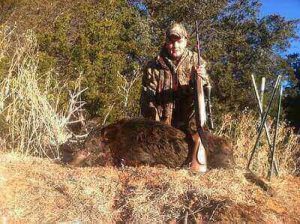
6. Look for hog signs like droppings, wallows, rubs, rootings, beds, tracks, travel lanes, and crossings.
7. Find out if there are any private lands nearby that the wild hogs retreat to when the hunting pressure is high on the public land.
8. Get familiar with the rules and regulations of the public land and follow them.
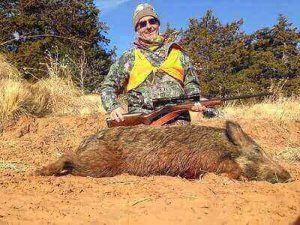
How To Track Hogs
Knowing how to track hogs is a crucial part of hunting hogs. When tracking wild hogs, there are some signs to be on the lookout for.
1. Rooting
Wild hogs will use their snout to uproot vegetation in search of tender roots, acorns, worms, and grub. When you locate areas with uprooted soil, chances are that is the work of wild hogs.
2. Hog Tracks
Learn the difference between deer and hog tracks. Wild hog tracks are wider and bigger than those of deer. They are nearly square and shorter than deer tracks. Hog tracks tend to be blunt at the tip of the toe while deer tracks are more pointed at the tip of the toe.
3. Scat
Be attentive to find hog droppings. They are usually cylindrical in shape and dark in color. It looks similar to that of dogs.
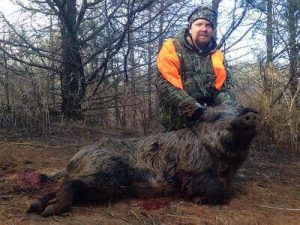
4. Wallows
Hogs like to cover their bodies with mud as a way to cool off from the hot weather and insects that bit them. They don’t have sweat glands, therefore, they resort to “wallowing” to cool down their body temperatures. If you spot hog tracks and scat near the wallows, then you can almost be certain the wallows were made by feral hogs.
5. Rubbing
Rubbing is another sign of feral hogs. After wallowing, they will use trees, posts, fences, and other stationary objects to remove the mud or clay from their bodies. Keep your eye open for trees, poles, and other objects covered with clay and mud.
6. Beds
Hogs will clear vegetation and dig a shallow bed in thick, nasty cover. The beds are usually large circular holes dug deep into the ground.
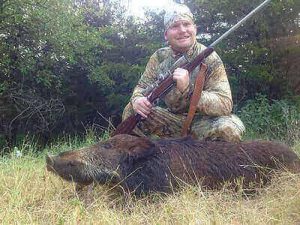
Hog Hunting Tips For Beginners
1. Hogs have poor eyesight but a very good sense of smell.
2. Wild hogs can grow very large, powerful, and aggressive if they are cornered.
3. Wild hogs have very sharp teeth that they can use to attack when in danger.
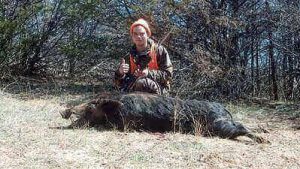
4. Feral hogs are most active early mornings and late evenings.
5. Predator calls will lure them out of cover but be prepared as they will come charging out.
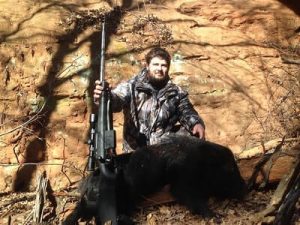
6. Wild hogs live in deciduous and mixed forests with food, water supply, and thick cover.
7. Look for private landowners who are having issues with wild hogs destroying their crops and farmland.
8. Hogs love water. Find water sources and camp near them and you will spot hogs.
9. Wild hogs like acorns, sweet potatoes, nuts, and overripe fruits.
10. Recorded sounds of piglets will always lure sows out in the open as they are very protective of their young.
11. Always be sure that you are downwind of the hogs. They have a very good sense of smell and will pick up your scent and leave if you are upwind of them.
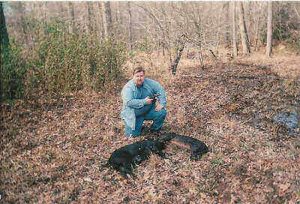
Hog Hunting Methods
There are two main methods of hunting feral hogs. They are the spot and stalk and the still-hunting methods.
1. Spot & Stalk
The spot and stalk method is ideal for dry and open country, not for areas that are thick with cover and visibility is limited. Hogs are most active early morning and late evenings. You will have to set up during these hours from a good vantage point to spot them when they move from bedding to feeding areas. it is then you make a judgment call as to whether you can stalk them.
2. Still-Hunting
With still-hunting you set up, considering the wind, in a position in which you can see the directions the hogs usually travel and wait for them. Treestands and ground blinds can be used to wait for the hogs. When you see and hear them, you wait patiently until you have a good shot and then take it.
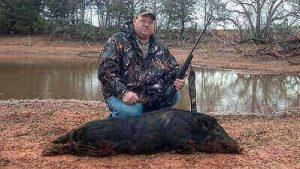
The Bottom Line
Hunting feral hogs have become very popular as states and land owners welcome hog hunters because wild hogs do a lot of damage to crops and the land. As a result, hunting hogs are seen as a way to control their population.
Wild hogs can be aggressive if they feel cornered. They grow to be large and powerful. In this article, we discuss how to hunt hogs in the daytime, at night, and on public land as well as how to track them. You can also read about the best pig hunting tips.
